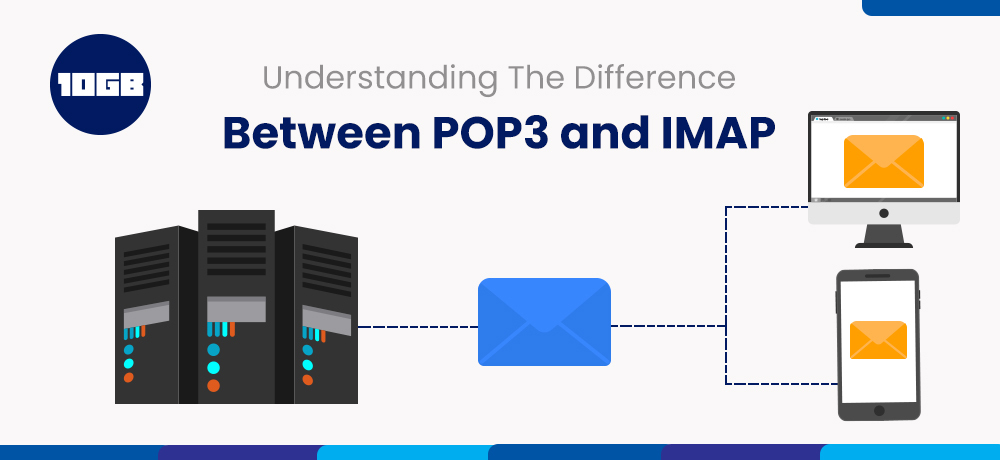We often use email but do we really know how email works and which email setup will be most suitable for my business? So In this article, I would like to address the difference between POP3 and IMAP.
Before getting started, we will look into a few email terminology that you should know so you get the maximum value from email for your business.
Email terminology that you should know
Email Server:
An email server is a machine that hosts your email which is generally offered when you buy a hosting package
Email account:
Most of you are aware of what an email account is. But for transparency in this blog, an email account is the data storage area for your emails where emails come and go (Inbox and Outbox).
Email Client:
An email client is a computer program that is utilized to create, read, and send emails and is the interface among the user and the mail server. Email clients utilize an email protocol (POP or IMAP) to download and read emails. Few instances of email clients incorporate:
- Windows Based: Eudora, MS Outlook, Outlook Express, Thunderbird
- Linux Based: Elm, Pine, and Mutt
Email client’s configuration usually needs credentials of accounts, server hostnames, and port numbers.
Webmail:
In contrast to email clients, Webmail directs to webmail applications or web-based mail access. through an URL you can access the hosted applications on the email server.
Email Protocol:
There are various stages to delivering an email to guarantee successful delivery these are determined by protocols i.e. POP and IMAP. We will discuss the difference between POP3 and IMAP later on.
Email Hosting:
Email Hosting is a web service that runs email hosting servers. In contrary to webmail services like Gmail and Outlook mail, email hosting services are generally best suited for businesses that:
- Need extra or additional space for their emails
- Want to brand their email addresses by their own domain name.
At 10GB Hosting, we give 2 different kinds of solutions for businesses- Professional Email, Enterprise Email. Additionally, G Suite by Google Cloud offers different productivity and collaboration tools.
What is the difference between POP3 and IMAP?
While configuring an email client like Outlook or Mail, the protocol that you want to use, needs to be defined. So the difference between POP3 and IMAP will help you understand how they can help you.
POP:
POP or the Post office Protocol is a protocol for retrieving emails. POP is also known as the ‘download-and-delete’ email protocol. The mail on a POP server is deleted as soon as you have downloaded it. The POP protocol is presently in its 3rd version.
- Few examples of POP3 Servers include- Dovecot, qmail, Sendmail, Exim, Microsoft Exchange
- Some examples of POP3 Clients- MS Outlook, Outlook Express, Thunderbird, Eudora
Pros:
- An easy process to access email
- POP allows yourself to download emails to your machine and read them despite while you are offline
- This helps in decreasing the volume of space your email account utilizes on the webserver.
Cons:
- It is a single direction communication from the mail server to an individual computer, following which it is removed from the server. If you try to reach your mail account from different devices, you will not be capable to view those emails.
- Sent mail is saved locally on your device and not on the mail server
- Even though there is an option to save a copy of your email on the server, this leads to duplicated copies of your mailbox on clients as well as on the server, and hence it makes managing the emails challenging.
IMAP:
On the contrary with POP3, in IMAP (Internet Messaging Access Protocol)configured email account are preserved on the server even following the user has downloaded it. As a matter of fact, IMAP was introduced as an option to POP3.
Pros:
- IMAP allows two-way communication among the mail server and the client. Emails are saved on the server yet after they are downloaded/accessed from various devices by many clients. It is marked as ‘read’ if you read a message from an IMAP server. In simple words, each of your activities through IMAP is synced
- Once the messages are downloaded, the copies yet reside on the server so that you can access at any time
- Unlike POP, an email in an IMAP setup is only downloaded when you click on it. Additionally, attachments are not automatically downloaded either. So, checking your email with IMAP is much faster and more effective
- Sent emails are saved on the server at any time you can access them
Cons:
- The emails will ultimately hold up a lot of the space on the server until you buy more extra space
- IMAP cannot be accessed offline
Out of the two, IMAP is surely a more competent choice for the current business world. I hope I have given you a fair knowledge of email terminology and in specific about the difference between POP3 and IMAP. Additionally, you can read the article “Difference Between Web Hosting and Domain” to know the differences.
